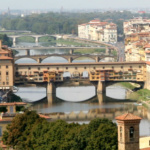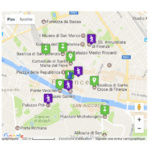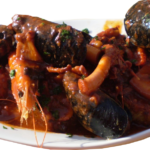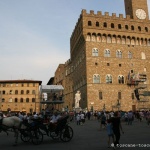The Tuscan cuisine is based on simple, high-quality ingredients, reflecting a strong rural identity and a long agricultural tradition. Bread, extra virgin olive oil, wine, vegetables, and local meats form the basis of many dishes, prepared to enhance the natural flavor of the products. Simplicity and seasonality are at the heart of this gastronomy.
In the Florence area, renowned meats are produced on farms in the Valdarno or Mugello, mainly beef, often enjoyed grilled. Olive trees are abundant, providing high-quality extra virgin olive oil, used to season most dishes, but also simply tasted on a slice of toasted bread, locally known as fettunta.
Also read 16 Tuscan dishes to try
Florentine and Tuscan specialties
Tuscan appetizer and cured meats
Crostini di fegatini are a typical specialty served as an appetizer: small toasts topped with a sauce made from chicken liver, butter, capers, anchovies, and onions, served on warm bread. Cold cuts are also widespread, including ham and other cured meats. One Florentine specialty is finocchiona, a sausage similar to salami, flavored with fennel seeds, or Lardo di Colonnata, rubbed with garlic and herbs. The soprassata, made from pig’s head, is also popular in local tradition.
Tuscan first courses (pasta, soups, etc.)
Pasta lovers will enjoy pappardelle (wide egg pasta ribbons) served with sauces made from wild boar or hare, as well as traditional seasonings like porcini mushrooms, meat sauce, artichokes, or sausage.
Tuscan cuisine is also famous for its peasant soups: pappa al pomodoro in summer (made with bread and tomatoes), ribollita in winter (bread, vegetables, beans, and black cabbage), cacciucco (Livorno fish soup), or carabaccia (onion soup), inherited from rural recipes using simple, local ingredients.
Panzanella is enjoyed in summer, made with stale bread, tomatoes, onions, and basil.
The Florentine steak (Fiorentina)
The iconic dish of Florence is undoubtedly the bistecca alla fiorentina, a thick T-bone steak from the Chianina breed, traditionally grilled and served rare. It is typically accompanied by Tuscan white beans (fagioli all’uccelletto) or grilled vegetables.
Tuscan desserts
In Tuscany, a typical dessert from Prato is cantuccini, crunchy almond biscuits dipped in Vin Santo, a sweet wine. In autumn and winter, desserts made with chestnut flour and pine nuts, such as castagnaccio, are also prepared. During Carnival, schiacciata alla fiorentina is enjoyed, a soft citrus-flavored cake, sometimes filled with cream or chocolate and dusted with powdered sugar.
Street food: tripe and lampredotto
Florentine cuisine has a strong popular and street tradition. Among the most famous snacks are sandwiches made with tripe or lampredotto (one of the cow’s stomachs), typically served in a round bread roll with green sauce (salsa verde) and sometimes a bit of chili. These specialties are still eaten today at city kiosks and markets, such as the Mercato Centrale.
Information and links
Suggestions for discovering Florence cuisine
Links in French
- Tuscan cuisine – Wikipédia: A comprehensive overview of Tuscan gastronomy, its origins, and iconic dishes.
- This guide delves into the essence of Tuscan food, emphasizing its simplicity and the quality of local ingredients.
Links for more information and recipes (Italian sites)
- Tuscan recipes on GialloZafferano
- 10 dishes to try in Tuscany – Visit Tuscany
- Typical Tuscan recipes on Cucchiaio d’Argento
- Typical Tuscan dishes – La Cucina Italiana
- Tuscan recipes on Sonia Peronaci
In the Florence category
- Florence
 Florence, the capital of Tuscany crossed by the ...
Florence, the capital of Tuscany crossed by the ... - What to see in Florence: monuments, squares and museums
 To explore Florence, at least 3 days are ...
To explore Florence, at least 3 days are ... - Interactive map of Florence
 Map of Florence with its major monuments, places ...
Map of Florence with its major monuments, places ... - Hotels in Florence
 Hotels in Florence
Hotels in Florence - Visit Florence in 2 or 3 days
 A three-day stay in Florence allows you to ...
A three-day stay in Florence allows you to ... - Tickets and tours in Florence
 Florence touristic pass and combined tickets Excursions, visites guidées ...
Florence touristic pass and combined tickets Excursions, visites guidées ... - 16 Tuscan foods to try
 The Tuscan cuisine, particularly Florentine, is a celebration ...
The Tuscan cuisine, particularly Florentine, is a celebration ... - Florence Cathedral
 The Cattedrale di Santa Maria del Fiore, symbol ...
The Cattedrale di Santa Maria del Fiore, symbol ... - Palazzo Vecchio of Florence and museum
 The Palazzo Vecchio (lit. “Old Palace”), one of ...
The Palazzo Vecchio (lit. “Old Palace”), one of ... - Ponte Vecchio
 The Ponte Vecchio (lit. “the Old Bridge”) is ...
The Ponte Vecchio (lit. “the Old Bridge”) is ... - Piazza della Signoria
 Piazza della Signoria is the political and historical ...
Piazza della Signoria is the political and historical ... - Churches in Florence
 Florence, the cradle of the Renaissance where architecture, ...
Florence, the cradle of the Renaissance where architecture, ... - Museums in Florence
 Florence, cradle of the Renaissance, is a true ...
Florence, cradle of the Renaissance, is a true ... - Uffizi Gallery
 La Uffizi Gallery in Florence is one of ...
La Uffizi Gallery in Florence is one of ... - Santa Croce Basilica in Florence
 The Basilica of Santa Croce, built beginning in ...
The Basilica of Santa Croce, built beginning in ... - Santa Maria Novella Basilica in Florence
 Santa Maria Novella is the large Dominican church ...
Santa Maria Novella is the large Dominican church ... - Palazzo Pitti, its museums and the gardens of Boboli
 Palazzo Pitti is one of the largest buildings ...
Palazzo Pitti is one of the largest buildings ... - Gallery of the Academy of Florence
 The Gallery of the Academy (Galleria dell’Accademia in ...
The Gallery of the Academy (Galleria dell’Accademia in ...


No Comments Yet